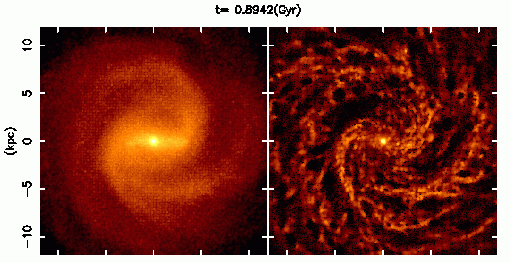Computational Astrophysics
The Computational Astrophysics page is now obsolete. Please see Astrophysics
Chemodynamical model of the Milky Way Disk
We are developing numerical simulation code, GCD+, to simulate the formation and evolution of the Milky Way. GCD+ is a three-dimensional tree N-body/smoothed particle hydrodynamics (SPH) code that incorporates self-gravity, hydrodynamics, radiative cooling, star formation, supernova feedback, and metal enrichment and follows the chemical enrichment history of both the stellar and gas components of the system. Therefore, GCD+ can track both chemical and dynamical (chemo-dynamical) information of galaxies. Using the chemo-dynamical simulations of the Milky Way-size disk, we are studying how the spiral structures are related to the star formation, and how the spiral structures affect the motion of the stars and gas. We will compare these simulations with the upcoming Gaia data, and disentangle the evolution of the Milky Way disk.

Face-on view of star (left) and gas (right) particle distribution in a simulated Milky Way sized disk. (courtesy of Robert Grand)
Additional Research Topics:
Resources:
Astrophysics Research:
Publications
Astrophysics Group Page
Connect with Astrophysics:
All Astrophysics News
MSSL Astrophysics Twitter
MSSL Astrophysics Blog
Head of Group:
Prof. Mark Cropper
+44 1483 204 155
m.cropper@ucl.ac.uk
 Close
Close

